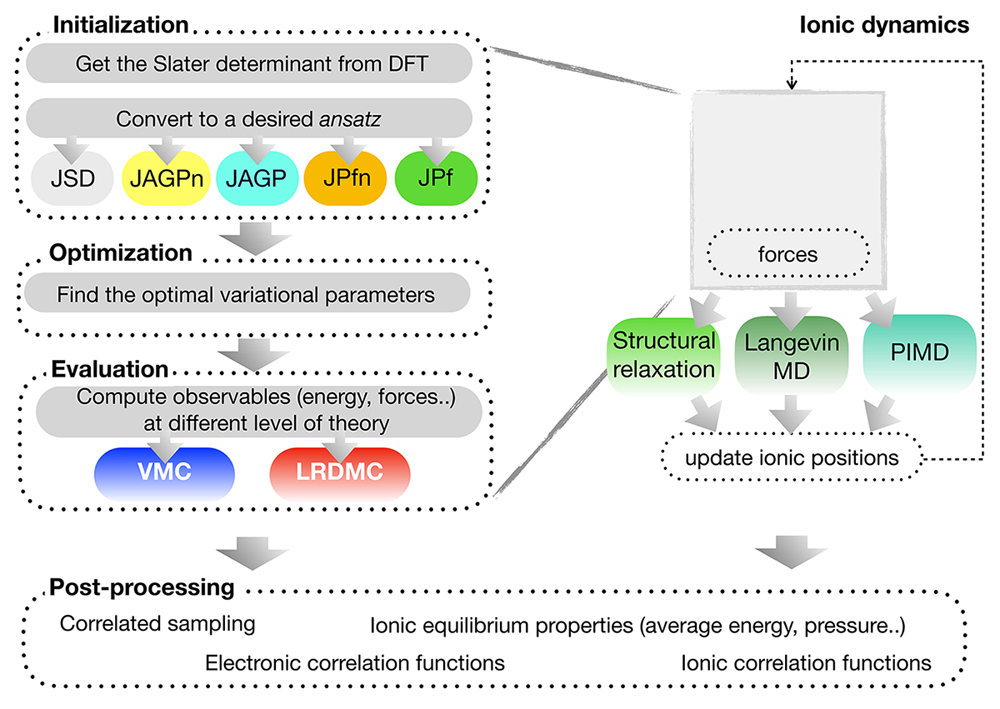Researchers have developed a first-principles quantum Monte Carlo package called "TurboRVB"
"TurboRVB" is a first-principles quantum Monte Carlo software package developed by Prof. Sandro Sorella (SISSA/Italy) and his collaborators. Very recently, Assist. Prof. Kosuke Nakano at Japan Advanced Institute of Science and Technology (JAIST/Japan) and his collaborators have published a review paper in The Journal of Chemical Physics [J. Chem. Phys. 152, 204121, 2020]. The published paper describes the details of the algorithms implemented in TurboRVB and summarizes its applications to date.
Main text:First-principles quantum Monte Carlo is a framework used to tackle the solution of the many-body Schrödinger equation by means of a stochastic approach. This framework is expected to be the next generation of electronic structure calculations because it can overcome some of the drawbacks in density functional theory and wavefunction-based calculations. In particular, the quantum Monte Carlo framework does not rely on exchange-correlation functionals, the algorithm is well suited for massively parallel supercomputers, and it is easily applicable to both isolated and periodic systems.
"TurboRVB" is a first-principles quantum Monte Carlo software package that was initially launched by Prof. Sandro Sorella (International School for Advanced Studies/Italy) and Dr. Michele Casula (Sorbonne University/France), and has been continuously developed by many contributors for over 20 years. Very recently, Assist. Prof. Kosuke Nakano at Japan Advanced Institute of Science and Technology (JAIST, President: Minoru Terano, located at Nomi, Ishikawa, Japan) and his collaborators have published a comprehensive review paper in The Journal of Chemical Physics [K. Nakano et al. J. Chem. Phys. 152, 204121, 2020, DOI: 10.1063/5.0005037].
TurboRVB is distinguishable from other first-principles quantum Monte Carlo codes in the following features. (a) The code employs resonating valence bond (RVB)-type wave functions, such as the Jastrow Geminal/Jastrow Pfaffian, which include the correlation effect beyond the Jastrow-Slater wave function that is commonly used in other QMC codes. (b) Implemented state-of-art optimization algorithms, such as the stochastic reconfiguration and the linear method, help realize a stable optimization of the amplitude and nodal surface of a many-body wave function at the variational quantum Monte Carlo level. (c) The so-called lattice-regularized diffusion Monte Carlo method is implemented in the code, which provides a numerically stable diffusion quantum Monte Carlo calculation. (d) The implementation of an adjoint algorithmic differentiation allows us to compute derivatives of many-body wave functions very efficiently and to perform structural optimizations and molecular dynamics simulations.
The published paper describes the details of the algorithms implemented in TurboRVB and summarizes its applications to date.

[Figure 1] Schematic figure of the TurboRVB workflow [K. Nakano et al. J. Chem. Phys. 152, 204121 (2020)]. The code implements flexible many-body wave function ansatz, such as JSD: Jastrow Slater, JAGP: Jastrow Geminal, and JPf: Jastrow Pfaffian. One can prepare a trial wave function using a build-in density functional theory (DFT) code and perform subsequent first-principles variational quantum Monte Carlo (VMC) and lattice discretized diffusion quantum Monte Carlo (LRDMC) calculations. Since forces acting on atoms can be computed, structural optimizations and molecular dynamics simulations are also feasible in TurboRVB.
[Links]
TurboRVB (English) [https://people.sissa.it/~sorella/TurboRVB_Manual/build/html/index.html]
June 1, 2020
